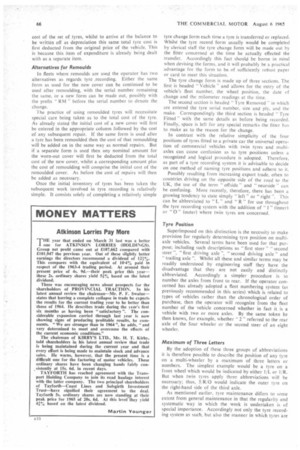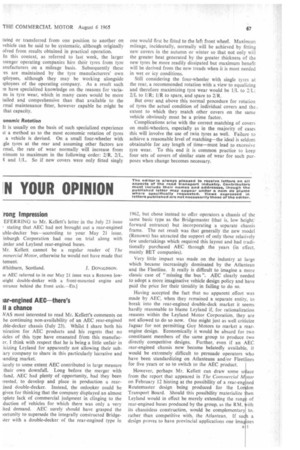Systematic Recording is Essential
Page 67

Page 68

Page 69

If you've noticed an error in this article please click here to report it so we can fix it.
AST week in this series a start was made in considering the setting up of a tyre recording system with the Jobject of achieving equitable costing and extended .e life. Whilst the function of efficient maintenance is achieve maximum life from all the components which to make up a commercial vehicle, tyre maintenance is tinctive—at least to some extent—in that it is persistent ention rather than elaborate equipment and facilities tich is most instrumental in achieving maximum tyre Accordingly the recording system allied to any tyre kintenance is of particular importance.
Before continuing with the examination of a recom:nded tyre recording system it must be reiterated here it the term " tyre " as commonly applied in any such :ording system does, in fact, refer only to the cover. hilst obviously the cost of tubes and flaps (assuming, as ierally applies to most commercial vehicles, that tubes tyres are not fitted) must be recorded and included in total cost of operation, it is normal practice to do this on the basis of average costing. The alternative of rec ing all tubes to individual vehicles is not worth the of the exercise in relation to the benefits, if any, achi A common reason for a reluctance to set up a recording system is the amount of work involved in ta the initial inventory of all tyres in the fleet. As inconvenient to take such an inventory in two or attempts because of the absence of some vehicles on one occasion, it is not unusual for it to be done over and additionally at week-ends when all vehicles are in the depot.
One Sheet per Tyre As pointed out last week the whole basis of su system is to have one record sheet or card for each The alternative of trying to keep track of all the tyres as original equipment on a new vehicle on one re sheet is not a practical proposition because of inevit interchange both between differing positions on the s vehicle and between different vehicles with similar equipment.
Accordingly, as described last week, the basic tyre re form is drawn up to facilitate the recording of the ii a tyre, including the mileage run in each of the se positions it may have been fitted. Similarly, on the of such mileage, an equitable proportion of overall can be attributed to the two or more vehicles to w it may have been fitted.
Establish Total Cost Before proportioning this overall cost on the basi of such separate mileages, however, it is first necesssar to
ensure that this overall cost is in fact the total cost. ere again suitable columns are provided on the tyre recor mg form to allow for such entries. The first entry wil , of course, be the actual cost of the cover. Incidentally, hen a new vehicle is brought into the fleet, although the res are not received individually as such, nevertheless the appropriate number of 'tyre record forms must be mad out in precisely the same way as when the same numb of new and additional tyres are received into stock. The cost of the original tyre equipment will be reckoned a the same price as corresponding tyres bought separa ely, despite the fact that the real cost of original equipme t is included in the price of the vehicle.
This procedure is in line with the division of the otal cost of operating the vehicle into 10 items, two of ich are tyre and depreciation costs. For the purpose of c lcu-. lating these two items tyre costs are based on the equiv lent 9 cost of the set of tyres, whilst to arrive at the balance to be written off as depreciation this same total tyre cost is first deducted from the original price of the vehicle. This is because this item of expenditure is already being dealt with as a separate item.
Alternatives for Remoulds
In fleets where remoulds are used the operator has two alternatives as regards tyre ,recording. Either the same form as used for the new cover can be continued to be used after remoulding, with the serial number remaining the same, or a new form can be made out, possibly with the prefix RM " before the serial number to denote the change.
The practice of using remoulded tyres will necessitate special care being taken as to the total cost of the tyre. As already stated the initial cost of a new cover will first be entered in the appropriate column followed by the cost of any subsequent repair. If the same form is used after a tyre has been remoulded then the cost of that remoulding will be added on in the same way as normal repairs. But if a separate form is used then any nominal amount for the worn-out cover will first be deducted from the total cost of the new cover, whilst a corresponding amount plus the cost of remoulding will comprise the initial cost of the remoulded cover. As before the cost of repairs will then be added as necessary.
Once the initial inventory of tyres has been taken the subsequent work involved in tyre recording is relatively simple. It consists solely of completing a relatively simple tyre change form each lime a tyre is transferred or replaced. Whilst the tyre record form usually would be completed by clerical staff the tyre change form will be made out by the fitter concerned at the time he actually effected the transfer. Accordingly this fact should be borne in mind when devising the forms. and it will probably be a practical advantage for the form to be. of sufficiently robust paper or card to meet this situation.
The tyre change form is made up of three sections. The first is headed " Vehicle" and allows for the entry of the vehicle's fleet number, the wheel position, the date of change and the milometer readings at the time.
The second section is headed " Tyre Removed" in which are entered the tyre serial number, size and ply, and the make. Correspondingly the third section is headed " Tyre Fitted " with the same details as before being recorded. Finally, space is left for any special remarks the fitter has to make as to the reason for the change.
In contrast with the relative simplicity of the four positions of tyres fitted to a private car the universal operation of commercial vehicles with twin tyres and multiaxles can cause confusion as to tyre positions unless a recognized and logical procedure is adopted. Therefore. as part of a tyre recording system it is advisable to decide on one method of naming tyre positions and adhere to it.
Possibly resulting from increasing export trade, often to countries driving on the opposite side of the road to the UK, the use of the term " offside " and "nearside " can be confusing. More recently, therefore, there has been a growing tendency to state simply " left " or "right ". This can be abbreviated to "L " and "R for use throughout the tyre recording system with the addition of " 1" (inner) or "0" (outer) where twin tyres are concerned.
Tyre Position Superimposed on this distinction is the necessity to make provision for regularly determining tyre position on multiaxle vehicles. Several terms have been used for that purpose; including such descriptions as "first steer" "second steer ", "first driving axle ", "second driving axle " and "trailing axle ". Whilst all these and similar terms may be readily understood by engineering staff they have the disadvantage that they are not easily and distinctly abbreviated. Accordingly a simpler procedure is to number the axles from front to rear. If the operator concerned has already adopted a fleet numbering system (as previously recommended in this series) which is related to types of vehicles rather than the chronological order of purchase, then the operator will recognize from the fleet number of the vehicle concerned whether in fact it is a vehicle with two or more axles. By the same token he then knows, for example. whether 2 referred to the rear axle of the four wheeler or the second steer of an eight wheeler.
Maximum of Three Letters
By the adoption of these three groups of abbreviations it is therefore possible to describe the position of any tyre on a multi-wheeler by a maximum of three letters or numbers. The simplest example would be a tyre on a front wheel which would be indicated by either 1/1[.. or 1/R. But when twin tyres apply three abbreviations wilt be necessary; thus, 3/R/0 would indicate the outer tyre on the right-hand side of the third axle.
As mentioned earlier, tyre maintenance differs to some extent from general maintenance in that the regularity and systematic way in which the work is undertaken is of special importance. Accordingly not only the tyre recording system as such, but also the manner in which tyres are tated or transferred from one position to another on vehicle can be said to be systematic, although originally Dived from results obtained in practical operation.
In this context, as referred to last week, the larger ssenger operating companieshire their tyres from tyre inufacturers on a mileage basis. Subsequently these vs are maintained by the tyre manufacturers' own iployees, although they may be working alongside tployees of the operating company. As a result such !ri have specialized knowledge on the reasons for varians in tyre wear, which in many cases would be more tailed and comprehensive than that available to the rmal maintenance fitter, however capable he might be that capacity.
onomic Rotation It is usually on the basis of such specialized experience it a method as to the most economic rotation of tyres
a vehicle is devised. On a small four-wheeler with gle tyres at the rear and assuming other factors are rmal, the rate of wear normally will increase from nimum to maximum in the following order: 2/R, 2/L, and 1/L. So if new covers were only fitted singly one would first be fitted to the left front wheel. Maximum mileage, incidentally, normally will be achieved by fitting new covers in the autumn or winter so that not only will the greater heat generated by the greater thickness of the new tyres be more readily dissipated but maximum benefit will be derived from the new treads when it is most needed in wet or icy conditions.
Still considering the four-wheeler with single tyres at the rear, a recommended rotation with a view to equalizing and therefore maximizing tyre wear would be 1/L to 2/1; 2/L to 1/R; 1/R to spare, and spare to 2/R.
But over and above this normal procedure for rotation of tyres the actual condition of individual covers and the extent to which they match other covers on the same vehicle obviously must be a prime factor.
Complications arise with the correct matching of covers on multi-wheelers, especially as in the majority of cases this will involve the use of twin tyres as well. Failure to achieve a reasonable level of matching—the ideal is seldom obtainable for any length of time—must lead to excessive tyre wear. To this end it is common practice to keep four sets of covers of similar state of wear for such purposes when change becomes necessary.












































































































